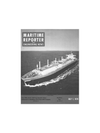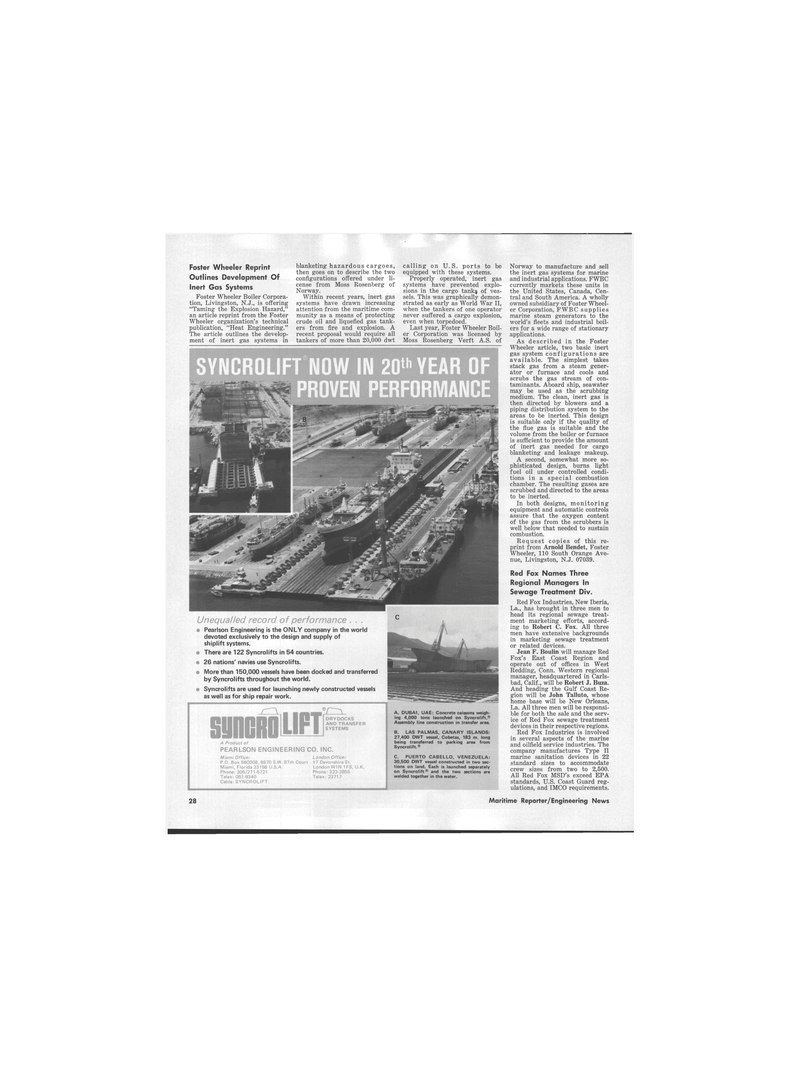
Page 3rd Cover: of Maritime Reporter Magazine (July 1978)
Read this page in Pdf, Flash or Html5 edition of July 1978 Maritime Reporter Magazine
Foster Wheeler Reprint
Outlines Development Of
Inert Gas Systems
Foster Wheeler Boiler Corpora- tion, Livingston, N.J., is offering "Taming the Explosion Hazard," an article reprint from the Foster
Wheeler organization's technical publication, "Heat Engineering."
The article outlines the develop- ment of inert gas systems in blanketing hazardous cargoes, then goes on to describe the two configurations offered under li- cense from Moss Rosenberg of
Norway.
Within recent years, inert gas systems have drawn increasing attention from the maritime com- munity as a means of protecting crude oil and liquefied gas tank- ers from fire and explosion. A recent proposal would require all tankers of more than 20,000 dwt calling on U.S. ports to be equipped with these systems.
Properly operated, inert gas systems have prevented explo- sions in the cargo tanks of ves_ sels. This was graphically demon- strated as early as World War II, when the tankers of one operator never suffered a cargo explosion, even when torpedoed.
Last year, Foster Wheeler Boil- er Corporation was licensed by
Moss Rosenberg Verft A.S. of
Norway to manufacture and sell the inert gas systems for marine and industrial applications. FWBC currently markets these units in the United States, Canada, Cen- tral and South America. A wholly owned subsidiary of Foster Wheel- er Corporation, FWBC supplies marine steam generators to the world's fleets and industrial boil- ers for a wide range of stationary applications.
As described in the Foster
Wheeler article, two basic inert gas system configurations are available. The simplest takes stack gas from a steam gener- ator or furnace and cools and scrubs the gas stream of con- taminants. Aboard ship, seawater may be used as the scrubbing medium. The clean, inert gas is then directed by blowers and a piping distribution system to the areas to be inerted. This design is suitable only if the quality of the flue gas is suitable and the volume from the boiler or furnace is sufficient to provide the amount of inert gas needed for cargo blanketing and leakage makeup.
A second, somewhat more so- phisticated design, burns light fuel oil under controlled condi- tions in a special combustion chamber. The resulting gases are scrubbed and directed to the areas to be inerted.
In both designs, monitoring equipment and automatic controls assure that the oxygen content of the gas from the scrubbers is well below that needed to sustain combustion.
Request copies of this re- print from Arnold Bendet, Foster
Wheeler, 110 South Orange Ave- nue, Livingston, N.J. 07039.
Red Fox Names Three
Regional Managers In
Sewage Treatment Div.
Red Fox Industries, New Iberia,
La., has brought in three men to head its regional sewage treat- ment marketing efforts, accord- ing to Robert C. Fox. All three men have extensive backgrounds in marketing sewage treatment or related devices.
Jean F. Boulin will manage Red
Fox's East Coast Region and operate out of offices in West
Redding, Conn. Western regional manager, headquartered in Carls- bad, Calif., will be Robert J. Buza.
And heading the Gulf Coast Re- gion will be John Talluto, whose home base will be New Orleans,
La. All three men will be responsi- ble for both the sale and the serv- ice of Red Fox sewage treatment devices in their respective regions.
Red Fox Industries is involved in several aspects of the marine and oilfield service industries. The company manufactures Type II marine sanitation devices in 22 standard sizes to accommodate crew sizes from two to 2,500.
All Red Fox MSD's exceed EPA standards, U.S. Coast Guard reg- ulations, and IMCO requirements.
Unequalled record of performance . . . • Pearlson Engineering is the ONLY company in the world devoted exclusively to the design and supply of shiplift systems. • There are 122 Syncrolifts in 54 countries. • 26 nations' navies use Syncrolifts. • More than 150,000 vessels have been docked and transferred by Syncrolifts throughout the world. • Syncrolifts are used for launching newly constructed vessels as well as for ship repair work.
Binnmi LIFT ^ DRYDOCKS AND TRANSFER SYSTEMS
A Product of
PEARLSON ENGINEERING CO. INC.
Miami Office:
P.O. Box 560008, 8970 S.W. 87th Court
Miami, Florida 33156 U.S.A
Phone: 305/271-5721
Telex: 051-9340
Cable: SYNCROLIFT
London Office: 17 Devonshire St.
London W1N 1 FS, U.K.
Phone: 323-2855
Telex: 23717
A. DUBAI, UAE: Concrete caissons weigh- ing 4,000 tons launched on Syncrolift.®
Assembly line construction in transfer area.
B. LAS PALMAS, CANARY ISLANDS: 27,400 DWT vessel, Cobetas. 183 m. long being transferred to parking area from
Syncrolift.®
C. PUERTO CABELLO, VENEZUELA: 30,500 DWT vessel constructed in two sec- tions on land. Each is launched separately on Syncrolift® and the two sections are welded together in the water. 14 Maritime Reporter/Engineering News

 23
23

 4th Cover
4th Cover
